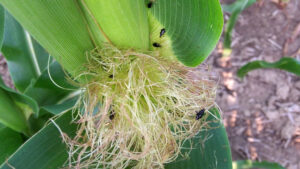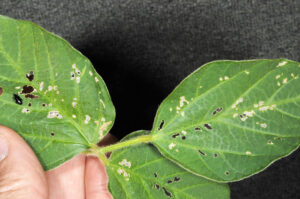As often happens, when weed control is delayed in fields, previously unseen insects become nuisance pests for the growing crop. This week, agronomists in central and northeastern Indiana, sent pictures with the “What is this bug?” question. We’ve had similar encounters with the redheaded flea beetle in past years. They have been observed feeding on corn leaves and silks, as well as soybean foliage. The redheaded flea beetle (Systena frontalis) normally feeds on weed species, especially giant ragweed. When weeds are burned down the beetles look no further than the crop for food, and will feed on leaves to a small extent. Plants near the field edge where non-crop plants will also be damaged, one of the common “edge effects” we see in many cropping systems. This feeding, while it catches attention, is nothing more than superficial, won’t affect pollination or yield and certainly doesn’t warrant treatment. But it’s worthwhile to know what this insect is, and why it’s suddenly feeding on corn.






